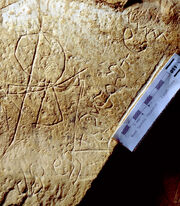
Wadi el-Ḥôl 2
The Wadi el-Ḥôl graffiti were found along an ancient Egyptian military road in the Western Egyptian desert. Along with the Proto-Sinaitic inscriptions, they are some of the earliest alphabetic inscriptions ever discovered. John Darnell et al. date them to the second half of Amenemhet II’s reign (1831-1806 b.c.e) based on contextual evidence.
The Wadi el-Ḥôl graffiti inscriptions constitute important evidence for the genesis and development of alphabetic writing. The individual letters are generally pictographic and are based on hieroglyphic and hieratic models. Moreover, the selection of specific letters was based on the acrophonic principle, the idea that the value, shape, and name of individual letters are all related. The letter for ˀ, for example, is shaped like the head of an ox (ˀalpu). Following the discovery of the Wadi el-Hôl graffiti, several scholars have argued that the alphabet was invented somewhere in Egypt, perhaps the Nile delta.
Bibliography
John C. Darnell, et al., “Two Early Alphabetic Inscriptions from the Wadi el-Ḥôl: New Evidence for the Origin of the Alphabet from the Western Desert of Egypt.” AASOR 59 (2005): 71-124.
Hamilton, Gordon. The Origins of the West Semitic Alphabet in Egyptian Scripts. CBQMS 40. Washington D.C.: The Catholic Biblical Association of America, 2006).